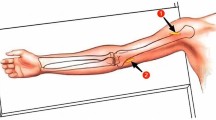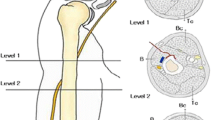Abstract
Background
Minimally invasive plate osteosynthesis (MIPO) has become a popular option for treatment of humeral shaft fractures. However, indirect reduction might risk unpromising results, with mal-alignment/mal-union or nonunion. The purpose of this study was to describe a reproducible MIPO technique that used an external fixator during the procedure as a tool for reduction and maintenance, and to assess the outcomes in patients with humeral shaft fracture.
Methods
Of 31 consecutive cases of humeral shaft fracture in 30 patients, 29 were included in this study. There were seven simple (type A) and 22 comminuted (type B or C) fractures. After the insertion of one Schanz pin on each proximal and distal humerus, a provisional reduction was achieved by connecting the pins with a monolateral external fixator. The MIPO procedure was then performed over the anterior aspect of the humerus. To evaluate the efficacy of the provisional reduction by external fixator, coronal and sagittal alignments were assessed. We also assessed bony and functional results, including complications, from this technique.
Results
There was no case of mal-union >10°, and mean angulation was 1.3° (range 0°–9°) in the coronal plane and 1.2° (range 0°–8°) in the sagittal plane. Twenty-eight of 29 fractures were united, including three delayed unions, with a mean union time of 19.1 weeks (range 12.3–38.4 weeks) and a mean follow-up of 20.8 months (range 13.5–31.0 months). There was one hypertrophic nonunion that healed after fixing with two additional screws. Except one patient with associated injury in the elbow, all patients recovered to pre-injury joint motion. There were two cases of postoperative radial nerve palsy that both recovered completely. We attributed them to manipulation, and not to the Schanz pins or plate fixation.
Conclusions
Surgical treatment of humeral shaft fractures with external fixator-assisted reduction and MIPO resulted in excellent reductions and high union rates.
Level of Evidence
IV




Similar content being viewed by others
References
Ekholm R, Tidermark J, Tornkvist H, Adami J, Ponzer S (2006) Outcome after closed functional treatment of humeral shaft fractures. J Orthop Trauma 20:591–596. doi:10.1097/01.bot.0000246466.01287.04
Sarmiento A, Kinman PB, Galvin EG, Schmitt RH, Phillips JG (1977) Functional bracing of fractures of the shaft of the humerus. J Bone Joint Surg Am 59:596–601
Heineman DJ, Poolman RW, Nork SE, Ponsen KJ, Bhandari M (2010) Plate fixation or intramedullary fixation of humeral shaft fractures. Acta Orthop 81:216–223. doi:10.3109/17453671003635884
Sarmiento A, Waddell JP, Latta LL (2002) Diaphyseal humeral fractures: treatment options. Instr Course Lect 51:257–269
Jiang R, Luo CF, Zeng BF, Mei GH (2007) Minimally invasive plating for complex humeral shaft fractures. Arch Orthop Trauma Surg 127:531–535. doi:10.1007/s00402-007-0313-z
Lopez-Arevalo R, de Llano-Temboury AQ, Serrano-Montilla J, de Llano-Gimenez EQ, Fernandez-Medina JM (2011) Treatment of diaphyseal humeral fractures with the minimally invasive percutaneous plate (MIPPO) technique: a cadaveric study and clinical results. J Orthop Trauma 25:294–299. doi:10.1097/BOT.0b013e3181f98421
Oh CW, Byun YS, Oh JK, Kim JJ, Jeon IH, Lee JH, Park KH (2012) Plating of humeral shaft fractures: comparison of standard conventional plating versus minimally invasive plating. Orthop Traumatol Surg Res 98:54–60. doi:10.1016/j.otsr.2011.09.016
An Z, Zeng B, He X, Chen Q, Hu S (2010) Plating osteosynthesis of mid-distal humeral shaft fractures: minimally invasive versus conventional open reduction technique. Int Orthop 34:131–135. doi:10.1007/s00264-009-0753-x
Jawa A, McCarty P, Doornberg J, Harris M, Ring D (2006) Extra-articular distal-third diaphyseal fractures of the humerus. A comparison of functional bracing and plate fixation. J Bone Joint Surg Am 88:2343–2347. doi:10.2106/JBJS.F.00334
Cheng HR, Lin J (2008) Prospective randomized comparative study of antegrade and retrograde locked nailing for middle humeral shaft fracture. J Trauma 65:94–102. doi:10.1097/TA.0b013e31812eed7f
Rommens PM, Kuechle R, Bord T, Lewens T, Engelmann R, Blum J (2008) Humeral nailing revisited. Injury 39:1319–1328. doi:10.1016/j.injury.2008.01.014
Bhandari M, Devereaux PJ, McKee MD, Schemitsch EH (2006) Compression plating versus intramedullary nailing of humeral shaft fractures-a meta-analysis. Acta Orthop 77:279–284. doi:10.1080/17453670610046037
Chapman JR, Henley MB, Agel J, Benca PJ (2000) Randomized prospective study of humeral shaft fracture fixation: intramedullary nails versus plates. J Orthop Trauma 14:162–166. doi:10.1097/00005131-200003000-00002
Kurup H, Hossain M, Andrew JG (2011) Dynamic compression plating versus locked intramedullary nailing for humeral shaft fractures in adults. Cochrane Database Syst Rev 15:CD005959. doi:10.1002/14651858.CD005959.pub2
Lin J, Shen PW, Hou SM (2003) Complications of locked nailing in humeral shaft fractures. J Trauma 54:943–949. doi:10.1097/01.TA.0000032252.57947.47
Scheerlinck T, Handelberg F (2002) Functional outcome after intramedullary nailing of humeral shaft fractures: comparison between retrograde Marchetti-Vicenzi and unreamed AO antegrade nailing. J Trauma 52:60–71. doi:10.1097/00005373-200201000-00012
Mahaisavariya B, Jiamwatthanachai P, Aroonjarattham P, Aroonjarattham K, Wongcumchang M, Sitthiseripratip K (2011) Mismatch analysis of humeral nailing: antegrade versus retrograde insertion. J Orthop Sci 16:644–651. doi:10.1007/s00776-011-0127-2
Apivatthakakul T, Arpornchayanon O, Bavornratanavech S (2005) Minimally invasive plate osteosynthesis (MIPO) of the humeral shaft fracture. Is it possible? A cadaveric study and preliminary report. Injury 36:530–538. doi:10.1016/j.injury.2004.05.036
Livani B, Belangero WD, Castro de Medeiros R (2006) Fractures of the distal third of the humerus with palsy of the radial nerve: management using minimally-invasive percutaneous plate osteosynthesis. J Bone Joint Surg Br 88:1625–1628. doi:10.1302/0301-620X.88B12.17924
Kobayashi M, Watanabe Y, Matsushita T (2010) Early full range of shoulder and elbow motion is possible after minimally invasive plate osteosynthesis for humeral shaft fractures. J Orthop Trauma 24:212–216. doi:10.1097/BOT.0b013e3181c2fe49
Ziran BH, Belangero W, Livani B, Pesantez R (2007) Percutaneous plating of the humerus with locked plating: technique and case report. J Trauma 63:205–210. doi:10.1097/01.ta.0000231870.11908.3e
Buckley R, Mohanty K, Malish D (2011) Lower limb malrotation following MIPO technique of distal femoral and proximal tibial fractures. Injury 42:194–199. doi:10.1016/j.injury.2010.08.024
Concha JM, Sandoval A, Streubel PN (2010) Minimally invasive plate osteosynthesis for humeral shaft fractures: are results reproducible? Int Orthop 34:1297–1305. doi:10.1007/s00264-009-0893-z
Zhiquan A, Bingfang Z, Yeming Q, Chi Z, Peiyan H (2007) Minimally invasive plating osteosynthesis of middle and distal third humeral shaft fractures. J Orthop Trauma 21:628–633. doi:10.1097/BOT.0b013e31815928c2
Gustilo RB, Anderson JT (1976) Prevention of infection in the treatment of one thousand and twenty-five open fractures of long bones: retrospective and prospective analyses. J Bone Joint Surg Am 58:453–458
Marsh JL, Slongo TF, Agel J, Broderick JS, Creevey W, DeCoster TA, Prokuski L, Sirkin MS, Ziran B, Henley B, Audigé L (2007) Fracture and dislocation classification compendium-2007: Orthopaedic Trauma Association classification, database and outcomes committee. J Orthop Trauma 21:S1–S133. doi:10.1097/00005131-200711101-00001
Langer JS, Gardner MJ, Ricci WM (2010) The cortical step sign as a tool for assessing and correcting rotational deformity in femoral shaft fractures. J Orthop Trauma 24:82–88. doi:10.1097/BOT.0b013e3181b66f96
Constant CR, Murley AH (1987) A clinical method of functional assessment of the shoulder. Clin Orthop Relat Res 214:160–164
Morrey BFAK, Chao EYS (1993) The elbow and its disorders. Saunders, Philadelphia
Chen AL, Joseph TN, Wolinksy PR, Tejwani NC, Kummer FJ, Egol KA, Koval KJ (2002) Fixation stability of comminuted humeral shaft fractures: locked intramedullary nailing versus plate fixation. J Trauma 53:733–737. doi:10.1097/00005373-200210000-00019
Livani B, Belangero WD (2004) Bridging plate osteosynthesis of humeral shaft fractures. Injury 35:587–595. doi:10.1016/j.injury.2003.12.003
Oh CW, Kim JJ, Byun YS, Oh JK, Kim JW, Kim SY, Park BC, Lee HJ (2009) Minimally invasive plate osteosynthesis of subtrochanteric femur fractures with a locking plate: a prospective series of 20 fractures. Arch Orthop Trauma Surg 129:1659–1665. doi:10.1007/s00402-009-0815-y
Fernandez Dell’Oca AA (2002) The principle of helical implants. Unusual ideas worth considering. Injury 33 Suppl 1:SA1–SA27. doi:10.1016/S0020-1383(02)00064-5
Cetik O, Uslu M, Acar HI, Comert A, Tekdemir I, Cift H (2006) Is there a safe area for the axillary nerve in the deltoid muscle? A cadaveric study. J Bone Joint Surg Am 88:2395–2399. doi:10.2106/JBJS.E.01375
Stecco C, Gagliano G, Lancerotto L, Tiengo C, Macchi V, Porzionato A, De Caro R, Aldegheri R (2010) Surgical anatomy of the axillary nerve and its implication in the transdeltoid approaches to the shoulder. J Shoulder Elbow Surg 19:1166–1174. doi:10.1016/j.jse.2010.05.010
Lögters TT, Wild M, Windolf J, Linhart W (2008) Axillary nerve palsy after retrograde humeral nailing: clinical confirmation of an anatomical fear. Arch Orthop Trauma Surg 128:1431–1435. doi:10.1007/s00402-008-0607-9
Ouyang H, Xiong J, Xiang P, Cui Z, Chen L, Yu B (2012) Plate versus intramedullary nail fixation in the treatment of humeral shaft fractures: an updated meta-analysis. J Shoulder Elbow Surg. doi:10.1016/j.jse.2012.06.007
Wang JP, Shen WJ, Chen WM, Huang CK, Shen YS, Chen TH (2009) Iatrogenic radial nerve palsy after operative management of humeral shaft fractures. J Trauma 66:800–803. doi:10.1097/TA.0b013e31816142cf
Shao YC, Harwood P, Grotz MR, Limb D, Giannoudis PV (2005) Radial nerve palsy associated with fractures of the shaft of the humerus: a systematic review. J Bone Joint Surg Br 87:1647–1652. doi:10.1302/0301-620X.87B12.16132
Venouziou AI, Dailiana ZH, Varitimidis SE, Hantes ME, Gougoulias NE, Malizos KN (2011) Radial nerve palsy associated with humeral shaft fracture. Is the energy of trauma a prognostic factor? Injury 42:1289–1293. doi:10.1016/j.injury.2011.01.020
Agel J, Jones C, Sanzone A, Camuso M, Henley MB (2004) Treatment of proximal humeral fractures with Polarus nail Wxation. J Shoulder Elbow Surg 13:191–195. doi:10.1016/j.jse.2003.12.005
Acknowledgments
This project (Ref: AOTAP12-23) was supported by AOTrauma Asia Pacific of AO foundation.
Conflict of interest
The authors declare that they have no conflict of interest.
Author information
Authors and Affiliations
Corresponding author
Rights and permissions
About this article
Cite this article
Lee, HJ., Oh, CW., Oh, JK. et al. Minimally invasive plate osteosynthesis for humeral shaft fracture: a reproducible technique with the assistance of an external fixator. Arch Orthop Trauma Surg 133, 649–657 (2013). https://doi.org/10.1007/s00402-013-1708-7
Received:
Published:
Issue Date:
DOI: https://doi.org/10.1007/s00402-013-1708-7




